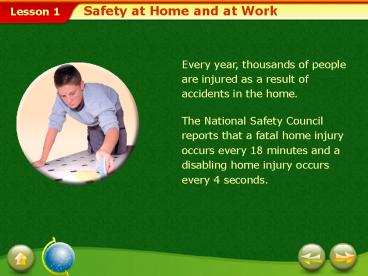Safety at Home and at Work - PowerPoint PPT Presentation
1 / 21
Title:
Safety at Home and at Work
Description:
Firearm Safety. Never point a firearm at anyone for any reason. ... Store firearms unloaded, and store the ammunition separately. ... – PowerPoint PPT presentation
Number of Views:160
Avg rating:3.0/5.0
Title: Safety at Home and at Work
1
Safety at Home and at Work
Every year, thousands of people are injured as a
result of accidents in the home. The National
Safety Council reports that a fatal home injury
occurs every 18 minutes and a disabling home
injury occurs every 4 seconds.
2
Lesson Objectives
In this lesson, youll learn to
- Analyze strategies for preventing accidental
injuries. - Explain how proper training at work can prevent
accidental injuries. - Demonstrate knowledge of strategies to prevent
accidental injuries at home and at work.
3
Accidental Injuries
Types of Injuries
- There are two types of injuriesintentional and
unintentional, or accidental. - An intentional injury is the result of a
deliberate attempt to cause harm. - One goal of Healthy People 2010 is to reduce the
number of deaths caused by unintentional or
accidental injuries.
4
Accidental Injuries
Strategies for Preventing Accidental Injuries
Although accidental injuries often seem to be
random events, experts have observed an accident
chain.
5
Safety at Home
Preventing Fires
- Three elementsfuel, heat, and oxygenmust be
present for a fire to occur. - Fuel can be carelessly stored rags, wood,
gasoline, or paper. - A heat source can be a lighted match, a damaged
electrical wire, a smoldering cigarette, or a
pilot light. - The oxygen in the air feeds and fans the flames.
6
Safety at Home
Tips to Avoid Unintentional Fires
7
Safety at Home
Fire-Safety Equipment
- One smoke alarm should be located on every floor
of a home, preferably outside a sleeping area and
near the kitchen. - The alarm should be tested once a month and
batteries should be replaced at least once a
year. - Check the dial on your fire extinguisher
periodically to ensure that it still has enough
pressure to work in an emergency. - When using an extinguisher, stand away from the
flames aim at the source of the fire, not at the
flames and move the spray from side to side.
8
Safety at Home
Preventing Falls
- Keep stairways well lit, in good repair, free of
clutter, and equipped with sturdy handrails and
nonskid stair strips. - Keep the floor clean and use nonskid throw rugs,
or place nonskid mats under rugs. - Make sure bathtubs and showers have safety rails.
- Do not run electrical or telephone cords across
areas where people walk. - If there are small children in the home, install
adjustable safety latches so that windows will
open only a few inches. - Use a sturdy step stool when reaching for items
in high places.
9
Safety at Home
Preventing Electrical Shock
- Unplug an electrical appliance immediately if
anything seems to be wrong. Always pull on the
plug, not the cord. - Inspect cords periodically for signs of cracked
insulation, and replace frayed cords immediately.
- Do not run cords under carpets or rugs.
- Check outlets and extension cords to make sure
they arent overloaded. - In homes with small children, cover unused
outlets with plastic protectors.
10
Safety at Home
Preventing Poisoning
- Keep medications and other potentially poisonous
substances in childproof containers and out of
the reach of children. - Dispose of any expired medications.
- Store all household chemicals in their original
containers. - Never mix household chemicals that could give off
toxic gases when combined. - Make sure there is adequate ventilation when
using fuel-burning appliances.
11
Safety at Home
Firearm Safety
- Never point a firearm at anyone for any reason.
- Treat all firearms as if they are loaded. If you
find a firearm, leave the area and tell an adult. - Store firearms unloaded, and store the ammunition
separately. - Both should be in locked cabinets that are well
out of the reach of children.
12
Safety at Home
Common Strategies for Safety at Home
13
Safety at Home
Computer Workstation Design
14
Safety on the Job
Preventing Injuries to Teens on the Job
- The Department of Labor prohibits anyone under 18
from doing - certain jobs, including
- Roofing and construction work.
- Demolition.
- Driving a forklift and any vehicle.
- Operating power-driven machinery.
- Handling explosives and radioactive materials.
- Both employees and employers must follow safety
rules issued - by the Occupational Safety and Health
Administration (OSHA).
15
Quick Review
Choose the appropriate option.
Q. An alarm that is triggered by the presence of
smoke is called a(n) _________________.
- fire hydrant
- accident chain
- smoke alarm
- fire extinguisher
16
Quick Review - Answer
A. An alarm that is triggered by the presence of
smoke is called a smoke alarm.
Click Next to attempt another question.
17
Quick Review
Provide a short answer to the question given
below.
Q. What are the five steps in the accident chain?
Click Next to view the answer.
18
Quick Review - Answer
- A. The five steps in the accident chain are
- Situation
- Unsafe habit
- Unsafe action
- Accident
- Result
Click Next to attempt another question.
19
Quick Review
Provide a short answer to the question given
below.
Q. What three elements must be present for a
fire to start?
Click Next to view the answer.
20
Quick Review - Answer
A. The three elements that must be present for a
fire to start are fuel, heat source, and oxygen.
Click Next to attempt another question.
21
Quick Review
Provide a suitable analysis.
Think of a specific job that a teen might have.
Analyze strategies for preventing accidental
injuries on that job, and develop a checklist
that features these strategies.































